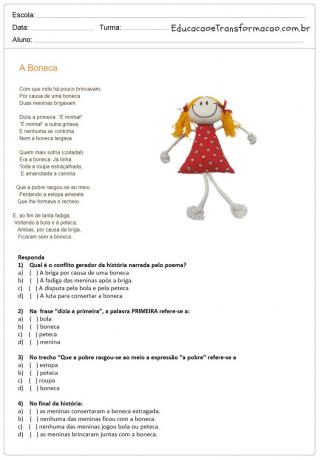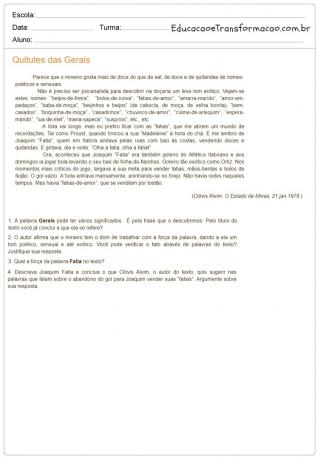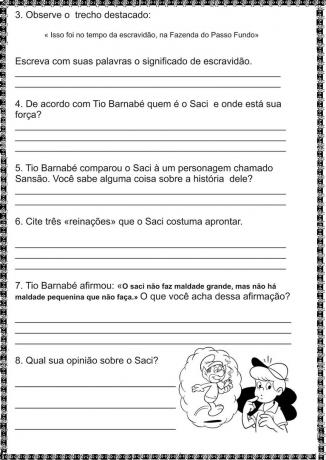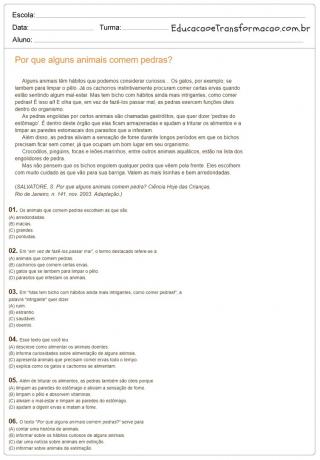
Check out the best 5 year interpreting activities, from elementary school to ready-to-print and apply to students.
All activities available here are free and already formatted with excellent quality.
See too:
Index
Check out some of the Exercises that we selected specifically for 5th grade students:
1) What is the generating conflict of the story narrated by the poem?
2) In the sentence "the first one said", the word FIRST refers to:
3) In the excerpt “That the poor was torn in half, the expression “the poor” refers to:
4) At the end of the story:


Long before Brazil became world champion in soccer, our ancestors were already making their “peals”. Only they weren't like today, of course, with beams, little flags, referee and fans. Football came much later, with its rules created by the English.
But the ball, or pelota, or balloon, or “girl”, or “round”, as soccer announcers say, was already used since prehistory. It is mentioned in the oldest books and in the oldest engravings. Home-
Ro and other writers from ancient Greece tell us that the ball game was considered important to give the body greater elasticity and grace. References are found about ball games among the Egyptians and even among the Hebrews, who were little dedicated to athletics.
The ancient Romans were not very fond of sports either. They enjoyed watching gladiator fights, it's true, but just watching: they didn't participate. For, even among them, ball games were very widespread.
Roman baths even had a room for these games, and many gentlemen had fields for ball games in their homes.
The old balls weren't like today's either. The first balls were made of pieces of leather sewn and “stuffed” from the most diverse materials. The smallest of balls, the harpastum, it was a very hard ball and pounded with feathers. The biggest, the follis, they were air-filled, made from animal bladders, much like today's balls.
The 2010 World Cup ball was developed by Adidas and is called “Jabulani”, meaning “to celebrate” in Bantu isiZulu dialect (one of eleven South African officials). With a predominance of white, the ball has African features in 11 different colors. With only 8 panels, the ball was developed with the most advanced technology, which will provide total stability.
Boy Scout Handbook. São Paulo: New Cultural.
(A) Brazilians
(B English
(C) French
(D) Africans
(A) orange, cornmeal, woman, wheel
(B) ciranda, grindstone, chubby, tomboy
(C) ball, balloon, girl, round
(D) turtledove, chubby, xuxinha, turtledove
(A) Since the creation of the first mascot the lion Willie in 1966.
(B) Since the first World Cup in 1930 in Uruguay.
(C) Since 1928 by Frenchman Jules Rimet.
(D) Since prehistory.
(A) Egyptians, Hebrews, Romans
(B) Greeks, Persians, Incas
(C) Mayans, Aztecs, Phoenicians
(D) Babylonians,
(A) crocodile leather and plastic filled with water.
(B) Tire rubber and air bladder.
(C) Made of sewn pieces of leather, stuffed with the most diverse materials, feathers and others made from animal bladders and filled with air.
(D) Sheep wool and sock balls, filled with sand.
(A) name of the first mascot of the 1966 World Cup and name of the second mascot of the 1970 World Cup.
(B) Very hard ball made of leather pieces and filled with different materials and small ball made of animal bladder, filled with air.
(C) name given to goals in Hearts and name given to players' fouls.
(A) one of the twelve official dialects of Brazil.
(B) one of the twelve official dialects of Argentina.
(C) one of the twelve official South African dialects.
(D) One of the twelve official Italian dialects.


4. Note the highlighted excerpt:
5. According to Uncle Barnabas who is SACI and where is its strength?
6. Uncle Barnabas compared SACI to a character called SANSÃO, do you know anything about his story?
7. Name 3 reigns that SACI USUALLY READY.
8. Uncle Barnabas said: “The saci does not do great evil, but there is no small evil that it does not do…”.
9. What is your opinion about SACI?


Excellent activities by GI Barbosa – Creative Idea.
I never had toys
I play with sea shells
And with the sand on the beach.
I play with coconut canoes
Knocked down by the wind.
I make paper boats
And my fleet sails
In the flood waters,
I play with the butterflies
on sunny days
And on full moon nights
I dress in the moonbeams.
In spring I weave fragrant wreaths,
The clouds in the sky are ships,
They are animals, they are cities,
I'm the richest boy in the world
Because I play with the Universe,
Because I play with Infinity.
(Maria Alice do Nascimento and Silva Leuzinger).
1) Copy the poem with great care and then make a beautiful illustration.
2) The boy plays with three stuff of the Universe. Name them.
3) With what to be of the Universe does the boy play?
4) What things does the boy build?
5) Remove from text:
a) words referring to plant nature.
b) words referring to animal nature.
c) words that refer to the celestial space.
d) words referring to liquid substances.
6) Why does the boy claim to be the richest boy in the world? What does your wealth consist of?
7) What does the boy decorate himself with?
8) Do you play with anything from nature? Talk about this joke.

Subscribe to our email list and receive interesting information and updates in your email inbox
Thanks for signing up.


